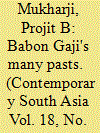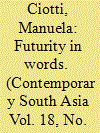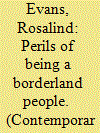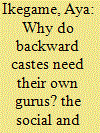|
|
|
Sort Order |
|
|
|
Items / Page
|
|
|
|
|
|
|
| Srl | Item |
| 1 |
ID:
099932


|
|
|
|
|
| Publication |
2010.
|
| Summary/Abstract |
Babon Gaji is a curious god. He is avowedly a Muslim, and the icons that represent him seek to capture his 'Muslim-ness' conspicuously in their attire, not to mention the name itself (Gaji = Ghazi = Muslim warrior-monk) and local lore. Yet he is worshipped by Brahmin Hindu priests who are equally conspicuous in flaunting their Hindu-Brahmin identity. There are no stories about the Gaji ever having been a Hindu or having had anything more than an intellectual interest in Hinduism. He remains, thus, in his afterlife a Muslim; yet, he receives worship through Brahmin priests. Both Hindus and Muslims come to him in large numbers today, in search of a cure for their afflictions. Local accounts place the origins of his shrine at Tajpur, South 24 Parganahs a little over 100 years ago, yet, no account of either the cult or the shrine - to the best of my knowledge - exists in the colonial archive. Neither are there any known written accounts outside the colonial archive that are more than a couple of decades old. For the historian of colonial medicine in the region, therefore, the Gaji presents a difficult challenge.
|
|
|
|
|
|
|
|
|
|
|
|
|
|
|
|
| 2 |
ID:
099926


|
|
|
|
|
| Publication |
2010.
|
| Summary/Abstract |
Drawing on ethnographic fieldwork in Uttar Pradesh, this article explores low-caste women political activists' self-representation. Low-caste communities have been mobilised to supra-local ideologies that posit 'classic' forms of subalternity such as the Dalit condition - and the rights and entitlements attached to it - as their rallying symbols. This article offers a counter-intuitive example to expressions of the burgeoning Dalit identity in north Indian society. In particular, it shows resistance to the usage of the Dalit label for self-representation by a number of low-caste women activists within the Bahujan Samaj Party. From women's narratives it emerges that 'Dalit' - implying a caste-laden ontological condition of subalternity - is denied on the grounds of its disempowering connotations. These narratives are all the more salient in consideration of the layered structure of gendered, socio-economic, cultural and political marginalities that low-caste women usually experience. While these findings unearth the discrepancies between subaltern pasts and cultures vis-a-vis their appropriation by low-caste women in contemporary north Indian society, they also point to vernacular understandings of 'Dalit' in circulation in the Uttar Pradesh public sphere. Moreover, these findings point to the need to de-link caste identity from agency, and to ethnography as a tool to (re)construct their nexus. Finally, by foregrounding the historicity of the Dalit label, this article encourages reflection on its widespread use.
|
|
|
|
|
|
|
|
|
|
|
|
|
|
|
|
| 3 |
ID:
099930


|
|
|
|
|
| Publication |
2010.
|
| Summary/Abstract |
Vivekananda Kendra describes itself as a 'spiritually oriented service mission', extensively influenced by both Swami Vivekananda and the Rashtriya Swayamsevak Sangh. As the name of the movement suggests, members of Vivekananda Kendra acknowledge their indebtedness to the inspiration of Vivekananda, a samnyasi. Vivekananda Kendra's organisation, however, is built around a lay leadership. Members emphasise this when explaining the values and goals of the Kendra, often consciously distinguishing between its model of leadership and the nature of its membership, and those of movements such as the Ramakrishna Math and Mission, where leadership is largely provided by samnyasis. This article explores the distinctive ethos of Vivekananda Kendra with particular reference to its lay leadership. The article draws on material gathered in a series of interviews with senior members of Vivekananda Kendra at the movement's headquarters at Kanyakumari in 2006 and 2008.
|
|
|
|
|
|
|
|
|
|
|
|
|
|
|
|
| 4 |
ID:
099925


|
|
|
|
|
| Publication |
2010.
|
| Summary/Abstract |
This article responds to Baud and van Schendel's call for research into the history of borderland people in order to redress 'the imbalance of "state-centred" studies'. It does so by providing a study of borderlands from the periphery, analysing the experiences of the Lhotshampas - a borderland people of Bhutan - who migrated there from Nepal and India a few generations ago. In response to the Bhutanese Government's efforts to promote a homogeneous national identity during the 1980s, Lhotshampa political leaders campaigned for increased political and cultural rights. The suppression of their early protests by the Bhutanese authorities ushered in a period of instability and conflict in the south, eventually resulting in the exodus of tens of thousands of refugees who have been living in camps in Nepal since the early 1990s. Through the use of secondary literature and refugees' memories, the article investigates the perspectives of ordinary villagers caught between the Bhutanese state and local elite political activists. It highlights the important role that oral histories can play in furthering our understanding of social and political dynamics in borderland areas.
|
|
|
|
|
|
|
|
|
|
|
|
|
|
|
|
| 5 |
ID:
099924


|
|
|
|
|
| Publication |
2010.
|
| Summary/Abstract |
Batticaloa district on the eastern coast of Sri Lanka has been one of the most disrupted and devastated areas of the island since civil war began in the early 1980s. Ethnically and culturally diverse, it has been under the control of different military actors; however, none had maintained full control, until May 2009 when the Sri Lankan Army successfully defeated the Liberation Tigers of Tamil Eelam. While political, social, developmental, and humanitarian issues in the East receive much scholarly attention, local actors are often cast through the dichotomy of victim and agency that often ignore the details and textures of daily life, which tell us not only about violence but also aspects of the everyday that negotiate through and outside of violence. Taking the question of the ordinary as the driving concept, this paper explores what is meant by an 'ordinary life' for Tamil-speaking communities in Batticaloa where people suffer, survive, and resist within the endurance of the everyday. Highlighting the spaces in which relationships can be strengthened, this paper argues that a capacity for hope, for building trust, and safety, however fragile and tentative, is as much an integral part of a conflict situation as the more obvious capacity for fear and silence.
|
|
|
|
|
|
|
|
|
|
|
|
|
|
|
|
| 6 |
ID:
099928


|
|
|
|
|
| Publication |
2010.
|
| Summary/Abstract |
Jati matha, as people of Karnataka call it, is a monastery that culturally and religiously represents a specific caste or sub-caste group, most of which are non-Brahmin, backward castes. From the Kuruba (shepherd caste, the largest amongst other backward classes) to Dalits (former untouchables) and Adivasis (tribals), the number of such caste-mathas is believed to be more than 100 in the state. This phenomenon presents interesting but problematic issues for conventional understandings of religious leadership and renunciation that regarded renunciation as a negation of the caste system. How can a renouncer represent a caste to which he/she belongs at the same time as claiming religious authority? It also reveals dynamic relationships between religion and politics in post-Mandal India. Is this a demand for spiritual reservation? While more backward class renouncers are receiving initiations, the distribution of resources through such caste-matha has become a tactic for the Bharatiya Janata Party-ruled state government to consolidate their support bases. The paper examines the complex negotiations and politics behind the emerging caste-mathas of Karnataka.
|
|
|
|
|
|
|
|
|
|
|
|
|
|
|
|
|
|
|
|
|